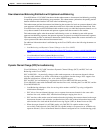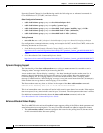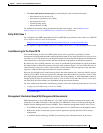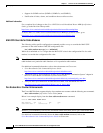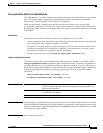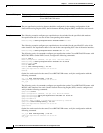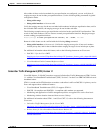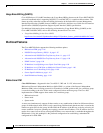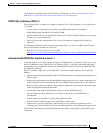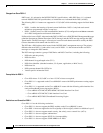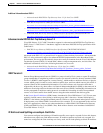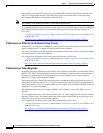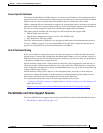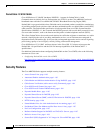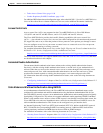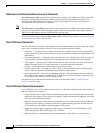
1-97
Cisco uBR7200 Series Universal Broadband Router Software Configuration Guide
OL-2239-05
Chapter1 Overview of Cisco uBR7200 Series Software
cops tcp window-size
For additional information about bidir-PIM and its configuration, refer to Configuring Bidirectional
PIM in the Cisco IOS IP Configuration Guide, Release 12.2 on Cisco.com.
DOCSIS Set-top Gateway (DSG) 1.0
The following DSG 1.0 features were added for multiple Cisco CMTS platforms in Cisco IOS release
12.3(9a)BC:
• Vendor names are supported to 20 characters per SNMP requirements (all platforms).
• SNMP MIB support introduced for the DSG-IF-MIB.
• Multicast MAC addresses are supported for DSG tunnels. DSG tunnel MAC addresses are no longer
limited only to unicast addresses.
• DSG 1.0 prevents the configuration of any reserved or otherwise inappropriate IP multicast
addresses.
For additional information about configuring and using DSG 1.0 on the Cisco uBR7246VXR router,
refer to the following document on Cisco.com:
• DOCSIS Set-Top Gateway for the Cisco CMTS
http://www.cisco.com/en/US/products/hw/cable/ps2217/products_feature_guide09186a00802065c8.html
Advanced-mode DOCSIS Set-Top Gateway Issue 1.1
Cisco IOS Release 12.3(13a)BC introduces support for DOCSIS Set-Top Gateway (DSG) Issue 1.1 on
the Cisco uBR10012 router. DOCSIS Set-Top Gateway (DSG) 1.1 introduces Advanced mode DSG
functionality based on Cablelabs specification CM-SP-DSG-I03-041124 on the Cisco uBR7246VXR
and uBR10012 platforms.
DSG 1.1 introduces support for several DOCSIS 1.1 networks and their multiple service operators
(MSOs):
• Supports advanced mode capabilities such as DCD, Regionalization, Fragmentation, and Quality of
Service (QoS).
• Retains the essential nature of out of band (OOB) messaging, but moves it to a modern technology base,
offering enhanced security for Multicast delivery of OOB messages dynamically to Set-top boxes.
• Replaces single-vendor, low-density, special-purpose equipment on the network, with significantly
increased subscriber bandwidth and traffic.
• Consolidates cable modem and STB data traffic on a shared DOCSIS channel.
• Increases high-speed data (HSD) services to cable TV subscribers over the DOCSIS 1.1
infrastructure,
• Extends support for DOCSIS 1.1 digital video broadcast traffic.
• Enables shared or dedicated support for either HSD or video traffic.
• Supports one- or two-way operations, and advanced, two-way interactive applications such as
streaming video, Web browsing, email, real-time chat applications, and targeted advertising services.
These powerful advantages maximize the performance and return of hybrid fiber-coaxial (HFC) plant
investments.



